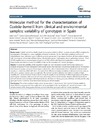Identificador persistente para citar o vincular este elemento:
https://accedacris.ulpgc.es/jspui/handle/10553/8620
| Título: | Molecular method for the characterization of Coxiella burnetii from clinical and environmental samples: variability of genotypes in Spain | Autores/as: | Jado, Isabel Carranza-Rodríguez, Cristina Barandika, Jesús F. Toledo, Álvaro García-Amil, Cristina Serrano, Beatriz Bolaños Rivero, M. Gil, Horacio Escudero, Raquel García-Pérez, Ana L Olmeda, A. Sonia Astobiza, Ianire Lobo, Bruno Rodríguez-Vargas, Manuela Pérez-Arellano, José L. López-Gatius, Fernando Pascual-Velasco, Francisco Cilla, Gustavo Rodríguez, Noé F. Anda, Pedro |
Clasificación UNESCO: | 2414 Microbiología | Palabras clave: | Borne Zoonotic Bacteria Acute Q-Fever Pcr Differentiation Identification, et al. |
Fecha de publicación: | 2012 | Publicación seriada: | BMC Microbiology | Resumen: | Background. Coxiella burnetii is a highly clonal microorganism which is difficult to culture, requiring BSL3 conditions for its propagation. This leads to a scarce availability of isolates worldwide. On the other hand, published methods of characterization have delineated up to 8 different genomic groups and 36 genotypes. However, all these methodologies, with the exception of one that exhibited limited discriminatory power (3 genotypes), rely on performing between 10 and 20 PCR amplifications or sequencing long fragments of DNA, which make their direct application to clinical samples impracticable and leads to a scarce accessibility of data on the circulation of C. burnetii genotypes. Results: To assess the variability of this organism in Spain, we have developed a novel method that consists of a multiplex (8 targets) PCR and hybridization with specific probes that reproduce the previous classification of this organism into 8 genomic groups, and up to 16 genotypes. It allows for a direct characterization from clinical and environmental samples in a single run, which will help in the study of the different genotypes circulating in wild and domestic cycles as well as from sporadic human cases and outbreaks. The method has been validated with reference isolates. A high variability of C. burnetii has been found in Spain among 90 samples tested, detecting 10 different genotypes, being those adaA negative associated with acute Q fever cases presenting as fever of intermediate duration with liver involvement and with chronic cases. Genotypes infecting humans are also found in sheep, goats, rats, wild boar and ticks, and the only genotype found in cattle has never been found among our clinical samples. Conclusions: This newly developed methodology has permitted to demonstrate that C. burnetii is highly variable in Spain. With the data presented here, cattle seem not to participate in the transmission of C. burnetii to humans in the samples studied, while sheep, goats, wild boar, rats and ticks share genotypes with the human population. | URI: | https://accedacris.ulpgc.es/handle/10553/8620 | DOI: | 10.1186/1471-2180-12-91 | Fuente: | BMC Microbiology [ISSN 1471-2180], v, 12 (91) |
| Colección: | Artículos |
Citas SCOPUSTM
36
actualizado el 08-jun-2025
Citas de WEB OF SCIENCETM
Citations
36
actualizado el 18-ene-2026
Visitas
68
actualizado el 10-ene-2026
Descargas
108
actualizado el 10-ene-2026
Google ScholarTM
Verifica
Altmetric
Comparte
Exporta metadatos
Los elementos en ULPGC accedaCRIS están protegidos por derechos de autor con todos los derechos reservados, a menos que se indique lo contrario.
